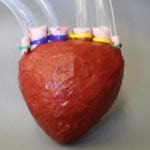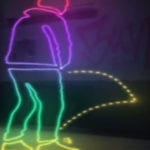 History
History  History
History  Creepy
Creepy 10 More Representations of Death from Myth, Legend, and Folktale
 Technology
Technology 10 Scientific Breakthroughs of 2025 That’ll Change Everything
 Our World
Our World 10 Ways Icelandic Culture Makes Other Countries Look Boring
 Misconceptions
Misconceptions 10 Common Misconceptions About the Victorian Era
 Mysteries
Mysteries 10 Strange Unexplained Mysteries of 2025
 Miscellaneous
Miscellaneous 10 of History’s Most Bell-Ringing Finishing Moves
 History
History 10 Great Escapes That Ended Right Back in Captivity
 Weird Stuff
Weird Stuff 10 Fascinating Things You Might Not Know About Spiders
 Food
Food 10 Everyday Foods You Didn’t Know Were Invented by the U.S. Military
 History
History 10 Most Influential Protests in Modern History
 Creepy
Creepy 10 More Representations of Death from Myth, Legend, and Folktale
 Technology
Technology 10 Scientific Breakthroughs of 2025 That’ll Change Everything
Who's Behind Listverse?

Jamie Frater
Head Editor
Jamie founded Listverse due to an insatiable desire to share fascinating, obscure, and bizarre facts. He has been a guest speaker on numerous national radio and television stations and is a five time published author.
More About Us Our World
Our World 10 Ways Icelandic Culture Makes Other Countries Look Boring
 Misconceptions
Misconceptions 10 Common Misconceptions About the Victorian Era
 Mysteries
Mysteries 10 Strange Unexplained Mysteries of 2025
 Miscellaneous
Miscellaneous 10 of History’s Most Bell-Ringing Finishing Moves
 History
History 10 Great Escapes That Ended Right Back in Captivity
 Weird Stuff
Weird Stuff 10 Fascinating Things You Might Not Know About Spiders
 Food
Food 10 Everyday Foods You Didn’t Know Were Invented by the U.S. Military
10 Remarkable Uses For Silicon
Silicon, one of the most important elements of recent times, is a vital component of high-powered integrated circuits and plasma-assisted lasers. Throughout history, the brittle, metal-like solid has been put to a multitude of fascinating uses, even prior to its discovery in 1824 (some sources say 1823). As the eighth most abundant element in the universe by mass, it accounts for a significant portion of the world we live in.
Today, we interact with silicon at so many points in our lives—from admiring a glittering gemstone to applying sealant to our bathrooms. We may not understand its full potential at present, but the range of remarkable properties offered by silicon means that it is likely to be at the forefront of any technological advances.
After all, as Bill Gates once said, “There will always be ignorance, and ignorance leads to fear. But with time, people will come to accept their silicon masters.”
10 Semiconductors And Microprocessors
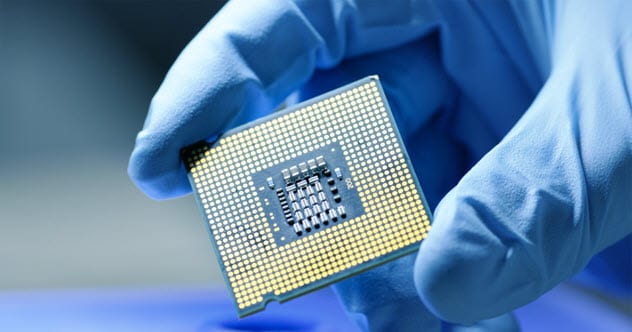
Semiconductors have revolutionized the modern world. Every time we use an electronic appliance, browse the web, or glance at our smartphones, we rely on semiconductors to perform a function. The device on which you are currently reading this article uses sophisticated semiconductors in its microprocessor and transistors, most probably made from silicon.
There are several notable atomic properties that make silicon a vital ingredient for state-of-the-art computing. It’s no coincidence that the Santa Clara Valley—the pioneering technological hub of the US—has been branded “Silicon Valley.” An enormous number of lucrative companies and budding start-ups—including Intel, Apple, Facebook, and Uber—depend on silicon chips and microprocessors.
Due to the intrinsic electron structure of the atoms, pure silicon crystals are strong insulators of electricity. Only a tiny amount of current is able to flow through. However, when another element is added into the mix in small doses, silicon changes properties from an insulator to a partial conductor of current—an actual “semi-conductor.” This process is known as doping.[1]
The simplest example of a semiconductor is a diode, a component found in circuits that conducts electricity in one direction and blocks it in the other. These are commonly used to make appliances like valves or radios. The semiconducting transistors found in microprocessors are essentially a more complex form of three-way diode.
9 Plant Growth

Silicon is the second most abundant element in the crust of the Earth. Oxygen is first. Our soil is naturally rich in silicon, and a number of broadleaf plants and grasses are able to absorb it into their tissues. Unlike minerals like phosphorus and nitrogen, silicon is not essential for plants to survive. However, for reasons that scientists are trying to determine, it has been observed to provide various benefits for some flora.
Silicon is said to be especially positive when plants face stress. Through absorption, plants improve their ability to withstand droughts and are able to survive longer stretches of time without water before wilting.
Moreover, in rice and wheat, silicon can improve the strength of the stem. Without it, they become weakened and may be damaged by the weather. In some cases, it has been found to make plants more resilient to attacks from fungal pathogens, too.
That said, silicon is only beneficial in moderation. Excess levels have been shown to impair and damage flowers in sunflowers and some species of daisy.[2]
8 Medical Silicone
![]()
Besides pure silicon, there are a number of other prolific silicon-based substances. Outside of its original form, silicon takes on a whole host of different properties. Naturally, it is a hard and brittle substance that behaves similar to a metal. Mixed with carbon, hydrogen, and oxygen, the element can be synthesized into the highly flexible rubber silicone.
Valued for its high versatility and excellent resistance to temperature and chemicals, silicone rubber has been put to a broad array of uses. From the 1960s onward, the material has rapidly become a popular choice for aerospace, electrical, and industrial manufacturers. The medical industry has also found a number of applications, including hearing aids, drainage tubing, and balloon catheters.[3]
Beyond rubber, silicone has also risen to prominence as a medical tool for its use in breast enlargements. Implants filled with silicone gel are inserted into the breasts to enhance their shape and size.
The option of saline solution implants is also available. However, the silicone ones are less likely to deflate or wrinkle and, in many cases, have been reported to give a more natural feel. Strange to think that a substance used as a sealant for airplanes is also a key component of cosmetic surgery.
7 Communicating With Extraterrestrials
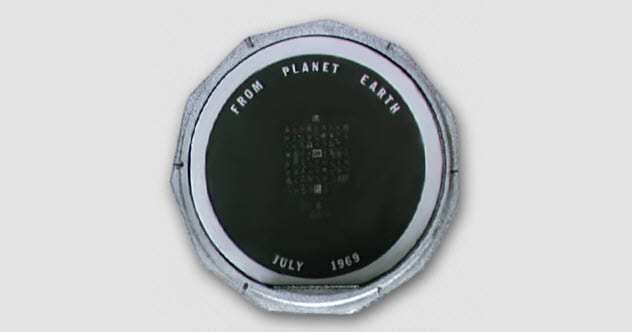
When Apollo 11 landed on the Moon in July 1969, the astronauts left behind a US flag, a commemorative plaque, and a small silicon disk around the size of a fifty-cent coin. Engraved on that disk are 73 bespoke messages, each one from the leader of a different country. Among the names included on the disk are Richard Nixon, Pope Paul VI, Queen Elizabeth II, Haile Selassie I, and Pierre Trudeau, father of the current Canadian prime minister.
To fit, the lettering had to be reduced 200 times until it was barely visible and smaller than the head of a pin. Also on the disk are the names of several historical US leaders and an inscription at the top that said, “Goodwill messages from around the world brought to the Moon by the astronauts of Apollo 11.”[4]
Temperatures on the Moon can fluctuate between 121 degrees Celsius (250 °F) and -173 degrees Celsius (-280 °F), so the disk material needed to be able to endure temperatures from both extremes. The statements were etched on the disk via a process used to build integrated circuits.
6 Silly Putty
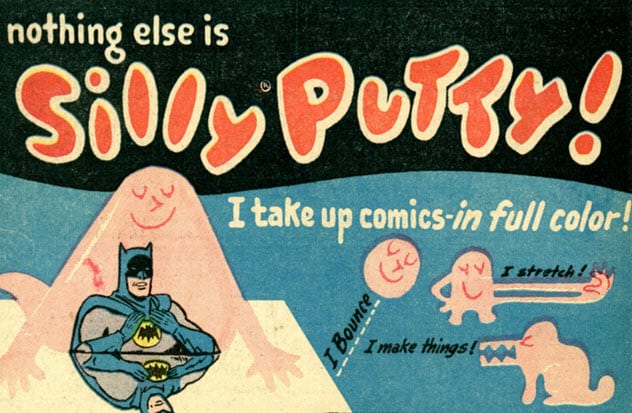
Rubber became scarce during World War II. The material was a pivotal asset for the Allied forces, who relied on rubber for the manufacture of gas masks, boots, and truck tires. Japan’s tactical 1942 invasion of Indonesia had entirely isolated the Allies from their rubber supply. They needed to react sharply or face defeat.
Scientists were sent scrambling to come up with a useful artificial substitute. In the process, American chemist Earl Warrick (who was later involved in the invention of silicone rubber) stumbled across an odd substance after he mixed silicone oil and boric acid. In another part of the country, James Wright, an engineer for General Electric, had made the same discovery independent of Warrick.
Their accidental creation was not a suitable alternative for rubber. Instead, they had produced a non-Newtonian fluid. When hit with a large burst of force, the fluid acts like a hard solid. Handle it delicately, and it oozes and flows like a liquid. Similar effects have been observed in custard, paint, and ketchup.
Unfortunately, despite the novelty putty becoming an enormous success, neither man made much money from it. Instead, businessman Peter Hodgson bought the production rights and earned millions, whereas Warrick, who patented the invention, got a dollar.[5]
5 Opals
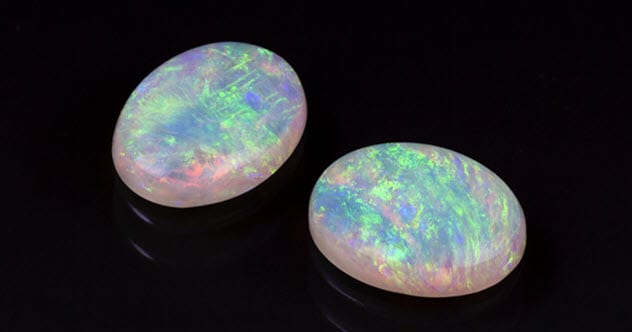
Popular among a number of high-profile historical leaders, the vibrant opal fetches its brilliant dazzle from the oxygen-rich compound silica. The gemstones are formed from tiny amorphous spheres of silica packed tightly together.
These spheres have a remarkable ability to refract passing light—an occurrence named “opalescence”—which lends opals their unique rainbowlike shimmer. The exact colors and wavelengths refracted depend on the internal structure of the silica.
Their striking appearance has made opals one of the most desirable gemstones throughout history and garnered several powerful advocates. Roman senator Nonius was sent into exile after he refused to sell a high-value opal to Mark Anthony. Queen Victoria and her daughters wore them often to great acclaim and gifted them to newlywed friends.
Around the turn of the 19th century, Napoleon Bonaparte gave his wife Josephine a spectacular crimson opal known as the “Burning of Troy” for its deep fiery hue.
In fact, Roman philosopher Pliny the Elder described opals as being superior to all other gemstones:
There is in them a softer fire than the ruby, there is the brilliant purple of the amethyst, and the sea green of the emerald—all shining together in incredible union. Some by their splendor rival the colors of the painters, others the flame of burning sulfur or of fire quickened by oil.[6]
4 Terracotta Army
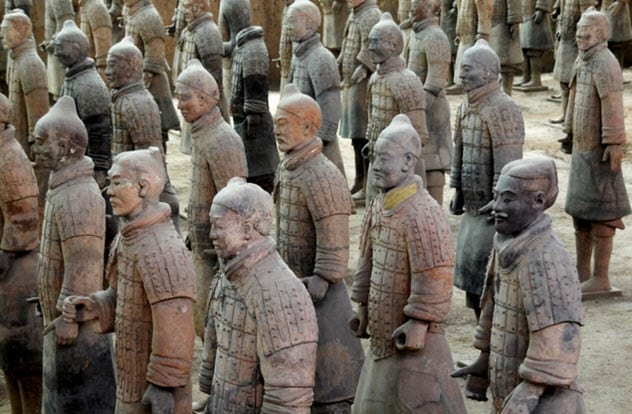
The Terracotta Army and quantum physics are a lot more closely linked than you might imagine. The two seemingly disparate subjects are connected by a synthetic pigment known as Han purple, an ancient coloring made from barium copper silicate.
Although its use petered out around AD 220, the vivid pigment rose to popularity around the time of the Zhou dynasty in China. Some traces remain in the terracotta sculptures at Qin Shi Huang’s resting place.
At extremely low temperatures, the silicon-based Han purple behaves in a rare and fascinating manner. As explained by physicists from Stanford University, any magnetic waves traveling through are stripped of one of their dimensions. Han purple actually transforms the three-dimensional into the two-dimensional. Some researchers believe that studies into the substance could be applied to the development of quantum computers.[7]
So how did an ancient Chinese dynasty gain access to such a scientifically complex color? The theory is they created it accidentally as a by-product while making glass.
3 Diatoms
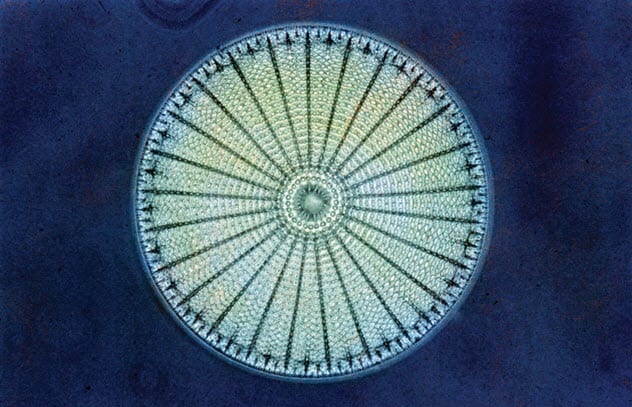
Encased in a silicon-based shell, the term “diatom” refers to a broad family of algae that lives in waters across the globe. The unicellular organisms have found themselves at the center of numerous studies due to their fascinating biological structure.
Each one is cocooned in a specialized cell wall known as a frustule that is made of silica, the same substance from which opals are formed. These highly embellished cases have earned diatoms the fitting title of “jewels of the sea.”
The frustule is not actually one continuous wall. Instead, it is formed of two differently sized overlapping halves—the larger epitheca and the smaller hypotheca. When a diatom reproduces, these two halves break apart. The separated silica halves go on to form new frustules by producing a second half-shell, which is usually smaller than the original.
Over time, diatoms become progressively smaller as they divide and multiply. Some have been known to decrease in size by 60 percent in a matter of months. To prevent the species from shrinking into oblivion, diatoms produce growth spores that restore them to their original size.[8]
2 The Roundest Object In The World
At the Australian Centre for Precision Optics in Sydney sits the roundest object in the world. The sphere is engineered to a phenomenal level of precision. If it was the size of the Earth, the difference between the lowest valley and the highest peak would be just 14 meters (46 ft). The raw materials alone cost an eye-watering one million euros. And it is made of pure silicon.
Engineers from the Avogadro Project created the supersmooth sphere to help determine a fundamental unit of measure. Since 1889, the kilogram has been defined by a small cylinder of platinum and iridium locked deep in a vault under Paris. This object is officially known as the International Prototype Kilogram, nicknamed “Big K.”[9]
However, for reasons that experts are unable to agree on, the mass of Big K has varied over the past 130 years and therefore needs to be replaced by a more reliable alternative.
The silicon sphere was one of the proposed successors to Big K. However, it was snubbed in favor of a different definition. Instead, on May 20, 2019, the kilogram will be redefined by a sophisticated instrument known as a watt balance.
1 A Design For Life?
![]()
Silicon-based life. Is the idea a far-fetched myth that exists only in the imagined worlds of science fiction, or is it a tangible possibility?
All life as we know it is built on the element carbon. Its properties make it the perfect building block for terrestrial life: It is abundant, it is an essential ingredient for a multitude of complex molecules, and each carbon atom has four electrons in its outer shell. All those properties are true of silicon as well.
That said, there are some fundamental differences between the two elements. The long molecular chains formed by silicon are much less stable than their carbon-based counterparts, and the chemical relationship between silicon and oxygen suggests that traditional respiration would be nearly impossible.[10]
Due to the intrinsic properties of the atoms, it is highly unlikely that silicon-based life could thrive on Earth. But we should not rule out the possibility altogether. Could there be silicon creatures dwelling in some distant recess of the cosmos? For now, the mystery remains.
Benjamin Thomas is a writer from Britain.
Read about more hypothetical forms of life, including those based on silicon, on 10 Scientifically Possible Extraterrestrial Life-Forms and 10 Hypothetical Forms Of Life.




